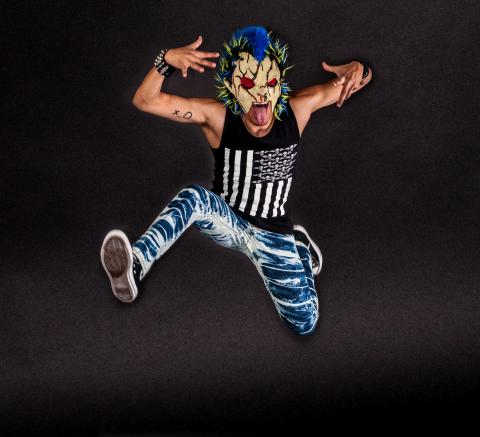In 2010, DJ BL3ND (real name withheld) started making videos and posting them to YouTube. At first, no one paid any attention to the teenager jumping around his room to hardcore electronic music. Then, at his parents’ insistence, he put on a mask that looked like a combination of Halloween’s Michael Meyers stitched together with Chuckie from Child’s Play and a 1980s glam rocker.
BL3ND danced hyperactively around his room in the mask to hard beats, but this time, something struck a chord, especially for rebelling teens. Soon, his viral YouTube videos had millions of hits and BL3ND was an in-demand DJ charging outrageous fees and traveling the globe. DJ BL3ND will be performing at ATT Show Box tonight.
“I never intended to be a mysterious person behind a mask,” BL3ND said in an e-mail interview with the Taipei Times.

Photo courtesy of DJ BL3ND
Now that he is known for his many different masks, BL3ND refuses to take them off. “I can express myself better with the mask on. Without a mask I’m just a normal person who you wouldn’t expect to be crazy,” he said.
Even though BL3ND has millions of fans on Facebook and across the globe, he claims he is a normal guy who likes to spend time with his family, dogs and friends when not listening to rock, hip-hop, old school jams and electronic music.
Like DJ Steve Aoki, who mixes two songs together and then hypes up the crowds by spraying champagne or throwing cake at them, DJ BL3ND makes sure that audiences get their money’s worth when they come to his shows by giving them his all. This means sometimes jumping out onto the crowd.
“Yes, I’ve gotten injured before. Not by crowd surfing, but by slipping on water and falling on a bass bottom at a show,” BL3ND said. “I ran back to the stage like nothing had happened, but I was actually just holding on to the pain.”
While BL3ND believes that image and music are both equally important, he knows deep down that anyone can be a viral video or two away from stardom. To the people who want to break into the DJ industry, his advice is: “Push a little harder to things you wouldn’t normally do.”
■ BL3ND performs tonight from 9:30pm to 4am at ATT Show Box, 7F, 12 Songshou Rd, Taipei City (台北市松壽路12號7樓). Tickets can be purchased at the door or iBon/FamiPorts for NT$2,000.

In the March 9 edition of the Taipei Times a piece by Ninon Godefroy ran with the headine “The quiet, gentle rhythm of Taiwan.” It started with the line “Taiwan is a small, humble place. There is no Eiffel Tower, no pyramids — no singular attraction that draws the world’s attention.” I laughed out loud at that. This was out of no disrespect for the author or the piece, which made some interesting analogies and good points about how both Din Tai Fung’s and Taiwan Semiconductor Manufacturing Co’s (TSMC, 台積電) meticulous attention to detail and quality are not quite up to

April 21 to April 27 Hsieh Er’s (謝娥) political fortunes were rising fast after she got out of jail and joined the Chinese Nationalist Party (KMT) in December 1945. Not only did she hold key positions in various committees, she was elected the only woman on the Taipei City Council and headed to Nanjing in 1946 as the sole Taiwanese female representative to the National Constituent Assembly. With the support of first lady Soong May-ling (宋美齡), she started the Taipei Women’s Association and Taiwan Provincial Women’s Association, where she

Chinese Nationalist Party (KMT) Chairman Eric Chu (朱立倫) hatched a bold plan to charge forward and seize the initiative when he held a protest in front of the Taipei City Prosecutors’ Office. Though risky, because illegal, its success would help tackle at least six problems facing both himself and the KMT. What he did not see coming was Taipei Mayor Chiang Wan-an (將萬安) tripping him up out of the gate. In spite of Chu being the most consequential and successful KMT chairman since the early 2010s — arguably saving the party from financial ruin and restoring its electoral viability —

It is one of the more remarkable facts of Taiwan history that it was never occupied or claimed by any of the numerous kingdoms of southern China — Han or otherwise — that lay just across the water from it. None of their brilliant ministers ever discovered that Taiwan was a “core interest” of the state whose annexation was “inevitable.” As Paul Kua notes in an excellent monograph laying out how the Portuguese gave Taiwan the name “Formosa,” the first Europeans to express an interest in occupying Taiwan were the Spanish. Tonio Andrade in his seminal work, How Taiwan Became Chinese,